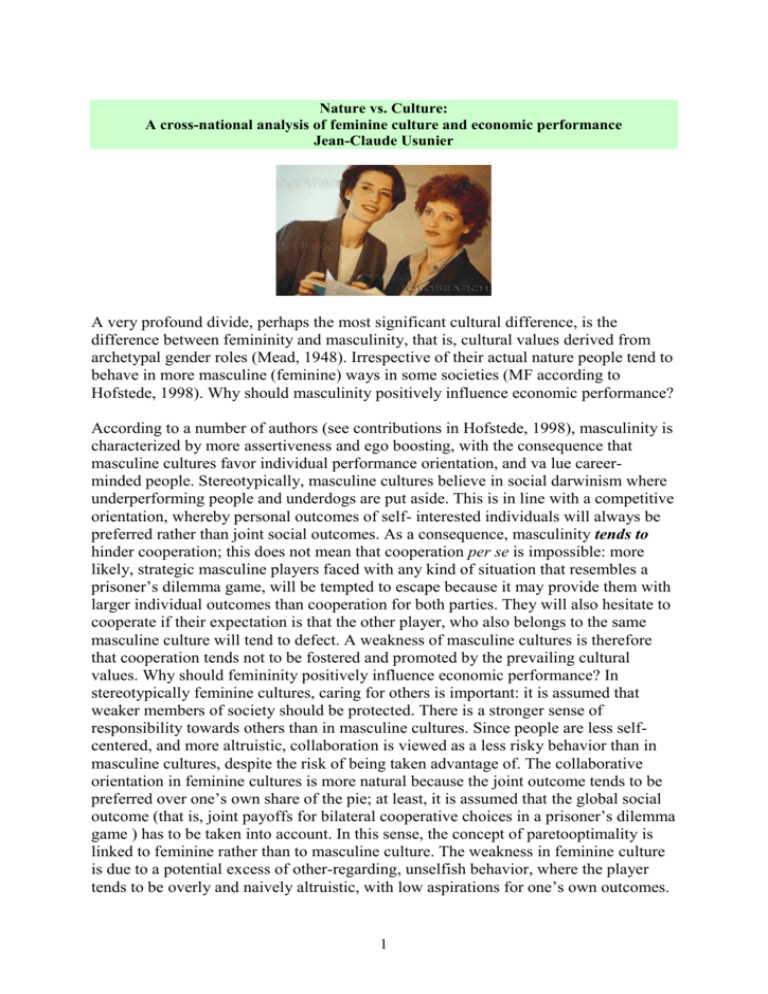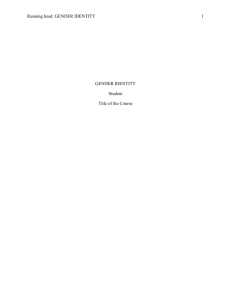Nature vs
advertisement

Nature vs. Culture: A cross-national analysis of feminine culture and economic performance Jean-Claude Usunier A very profound divide, perhaps the most significant cultural difference, is the difference between femininity and masculinity, that is, cultural values derived from archetypal gender roles (Mead, 1948). Irrespective of their actual nature people tend to behave in more masculine (feminine) ways in some societies (MF according to Hofstede, 1998). Why should masculinity positively influence economic performance? According to a number of authors (see contributions in Hofstede, 1998), masculinity is characterized by more assertiveness and ego boosting, with the consequence that masculine cultures favor individual performance orientation, and va lue careerminded people. Stereotypically, masculine cultures believe in social darwinism where underperforming people and underdogs are put aside. This is in line with a competitive orientation, whereby personal outcomes of self- interested individuals will always be preferred rather than joint social outcomes. As a consequence, masculinity tends to hinder cooperation; this does not mean that cooperation per se is impossible: more likely, strategic masculine players faced with any kind of situation that resembles a prisoner’s dilemma game, will be tempted to escape because it may provide them with larger individual outcomes than cooperation for both parties. They will also hesitate to cooperate if their expectation is that the other player, who also belongs to the same masculine culture will tend to defect. A weakness of masculine cultures is therefore that cooperation tends not to be fostered and promoted by the prevailing cultural values. Why should femininity positively influence economic performance? In stereotypically feminine cultures, caring for others is important: it is assumed that weaker members of society should be protected. There is a stronger sense of responsibility towards others than in masculine cultures. Since people are less selfcentered, and more altruistic, collaboration is viewed as a less risky behavior than in masculine cultures, despite the risk of being taken advantage of. The collaborative orientation in feminine cultures is more natural because the joint outcome tends to be preferred over one’s own share of the pie; at least, it is assumed that the global social outcome (that is, joint payoffs for bilateral cooperative choices in a prisoner’s dilemma game ) has to be taken into account. In this sense, the concept of paretooptimality is linked to feminine rather than to masculine culture. The weakness in feminine culture is due to a potential excess of other-regarding, unselfish behavior, where the player tends to be overly and naively altruistic, with low aspirations for one’s own outcomes. 1 Negotiation research has shown that lower individual aspirations lead to lower joint outcomes (Pruitt and Lewis, 1975). Practised on both sides, cultures being composed of interacting individuals who share the same values, feminine culture may lead to low motivation for economic achievements. As a consequence of these compensatory influences, both competition and cooperation being necessary for economic performance (EP), in both feminine and masculine cultures, we expect that feminine (respectively masculine, since they are opposed on a continuum) culture should have no direct influence on aggregate economic performance (H1). Nature versus culture: some elements for a debate about gender and economic performance Women have been heavily involved in their own efforts towards emancipation over the last century at least in a number of societies (i.e. in ex-communist countries as well as in developed, industrial economies) by recognizing their political, economical, as well as human rights with the consequence that participation of women in society has increased over the last 60 years. The whole political debate about women’s participation throughout this period has centered around formal rights, numbers, and quotas. However, a key issue is whether women have brought “their values” with themselves when reaching more influential positions in society (in government, civil service, education, corporate world). This is a complex issue: gender is both about nature and culture. Two provocative questions help illustrate a debate that has never been instigated: 1/ have more men adopted feminine values as a consequence of increased female participation? 2/ When men endorse feminine values, do they have the same chances of being promoted as if they had adopted the prevailing masculine values? Has the input of feminine culture increased in the realm of organizational life as a consequence of increased female participation? To sum up: Have legal and social evolutions automatically produced cultural change? The issue of cultural change is particularly relevant especially in terms of how and to what extent women and men share common values. Within a given feminine society feminine values tend to be propagated to both women and men. Conversely women in masculine societies tend to endorse attitudes and behaviors that are consistent with masculine values. As a consequence, it is not at all obvious that feminine culture increases with an increasing participation of women in economic and social life. We can assume the possibility of a discrepancy between increased female participation and feminine culture. Let us assume that women only reach higher positions when they in some way or another endorse masculine attitudes and behaviors, especially competitive orientation and assertiveness which are needed for being chosen over and against others, males included. “Masculinization” is the case when women have a very limited place in a particular society (i.e. it is traditionally male dominant and this dominance is entrenched in local 2 mores and legal systems), and the local culture is masculine (prototype: most Arab countries, including Egypt and Saudi Arabia with MF score at 53). “Conflicting dominance” occurs when the same type of traditionaly male dominant society combines with a relatively high level of femininity in the local culture; there are a number of such examples, particularly Iran (a feminine country with a score of 43), Indonesia (MF score = 46) or East African countries. Male dominance seems deeply associated with the traditional and conservative orientation of most collectivistic countries. We have regressed a number of indicators of male dominance on the individualism/collectivism (IC) scale. The IC scale ranges from 6 (Guatemela, the lowest individualism, consequently the most collectivistic country according to Hofstede, 2001) to 91 (the United States, the most individualist country in the world). Collectivism is negatively correlated with the Human Development Index 2001 (p<.000, 63 countries), with female activity rate as a percentage of male rate for ages 15 and above (p<.002, 63 countries), with female employment in services (p<.018, 56 countries). Collectivism is associated with less female professional and technical workers (p<.068, 50 countries), and a lower ratio of estimated female to male earned income (coefficient of .6, p<.000, 48 countries ) but positively correlated with female employment in agriculture (p<.011, 51 countries). Collectivism is also associated on average with less seats in parliament (p<.000, 61 countries), more recent the parliamentary decision to grant women the right to vote (p<.008, 61 countries), and it is negatively correlated with the Gender Empowerment measure (p<.000, 48 countries). Additionally, collectivism is positively correlated with the total fertility rate (p<.001, 63 countries) and with the mortality rate under the age of five (p<.005, 62 countries). However, we expect more complex logics to explain the link beween EP (economic performance) and MF. Masculinity / feminity may work in association with other cultural values, especially individualism/collectivism for reasons exposed above. This suggests that MF may influence EP both in isolation and as an interaction effect. We expect many women have been obliged to adopt masculine values in organizations in order to be promoted; conversely, those who do not adopt masculine values, and this more than for simple lip service have reduced chances of being promoted (i.e. the “masculine parity”. We may hypothesize that increased participation of talented women results in increased economic performance in societies with more masculine and individualist values. More precisely the more a society scores high on both individualism and masculinity (interaction term between both cultural dimensions), the higher its economic performance (H2). Conversely, when collectivism is associated with femininity in a particular country (as in the model of “conflicting dominance”), its economic performance will significantly decrease . Our key issue is whether women remain faithful to and continue to put into practice « their » values once they reach more influential positions in society (i.e. in government, education, the corporate world, etc.). Said differently, does women’s increased participation lead to the feminization of cultures ? An empirical test of such an 3 hypothesis would typically require a diachronic design in which we should be able to sketch both “natural” and “cultural” data over a long period of time. Unfortunately, we have no longitudinal data available (time series) that could represent the cultural phenomenon of « feminization » or « masculinization » of cultures. This is impossible to verify as we have no time series but only cross-sectional data as concerns feminine culture. A longitudinal analysis (based on time series data per country) would probably confirm that GDP/capita has risen with increased female participation in the workforce: the human capital base has been massively broadened by adding female talent. In fact, GDP/capita is positively correlated with female activity rate as a percentage of male rate for ages 15 and above (p<.003, 79 countries). In the absence of such longitudinal data for cultural variables, cross-sectional data (contrasting countries with masculine and feminine cultures at comparable time periods) offers a proxy view of the phenomenon, although with some caveats as it substitutes temporal variance for spatial variance. It is however, an important shortcoming in this research, which only provides an indirect answer to the very significant issue of feminization for managers as well as organizations. In fact, there are societies, which are relatively balanced in terms of masculine and feminine culture, that is, their MF score is near the world average, showing that the overall tendency is very slightly masculine or very slightly feminine. We assume that in such societies neither pole is strongly privileged in societal values, and the necessary coexistence and compromises between collaboration and competitive spirit will be achieved more easily. On the contrary, if a society is highly feminine or highly masculine, there will be some sort of loss of balance that may be conducive, ceteris paribus, to lower EP (H3). To sum up, we expect masculinity as a whole to be significantly negatively related to EP when the positive effect of interaction with individualism on EP and the positive effect of MF balance are taken into account. Discussion and implications The distribution of roles between the sexes is another fundamental issue for any society to which a range of solutions are found. The analysis of the IBM data revealed that (a) women's values differ less among societies than men's values; (b) if we restrict ourselves to men's values (which vary more from one country toanother), we find that they contain a dimension from very assertive and competitive and maximally different from women's values on the one side, the modest and caring and similar to women's values as the other. We have called the assertive pole "masculine" and the modest, caring pole "feminine". The women in the femininecountries have the same modest, caring values as the men; in the masculine countries they are somewhat assertive and competitive, but not as much as the men, so that these countries show a gap between men's values and women's values. Feminine culture limits the negative sides of masculine competitiveness, ego boosting, and not caring for others. It is a natural process of considering dependence on others as 4 well as one’s own interests which is a key issue in negotiation (Pruitt, 1981; Pruitt and Lewis, 1975), a requisite for non- hierarchical conflict resolution in both organizational life and interpersonalrelationships. If we consider the economic process of resource allocation as a macrobargaining game where people and groups of individuals negotiate how resources should be allocated, then MF should have some sort of meta-influence on economic performance. It should lead partners belonging to feminine cultures to more integrative solutions while more competitive views of interactions should be observed in masculine cultures. In Hofstede's operationalization, femininity and masculinity are seen as opposite polar positions on a linear continuum. What if they were two different dimensions rather than a bipolar dimension? Hofstede (1998) explains that the two scale Bem Sex Role Inventory (BSRI) questionnaire partitioned subjects in four groups (Bem, 1974), masculine only, feminine only, androgynous subjects who scored high on both masculine and feminine items and undifferentiated people who scored low on both masculine and femine items. Hofstede argues further that the BSRI was designed as an instrument dealing with individual level measurement while the masculinity/feminity dimension results from an ecological analysis, at the country level. “At the level of country means, ‘more people with feminine values’ is statistically so strongly correlated with ‘fewer people with feminine values’ that this becomes one single dimension.” (Hofstede, 1998, page 19) Our empirical approach is based on a large cross-sectional sample of countries, limited by the availability of cultural scores for only 64 countries. It is quite representative of the world’s cultures: most important nations are included in the sample with the notable exception of China. However, Hong Kong, Taiwan and Singapore are reasonable proxies for the Chinese culture. One of the key findings is that masculine culture per se is detrimental to economic performance. However, it appears to have a double and contradictory influence because of its positive influence when combined with individualism in an interaction term. There is strong positive dynamics in masculine values, based on self- interest, competitive spirit and high motivation for self-centered achievements. However, it is like a two-sided coin: masculine culture has advantages and drawbacks, most of them being related to the relative lack of concern for others that may reduce the level of trust necessary for managing joint activities and undermine cooperative behaviors. As we have argued earlier in this paper, « natural » rather than « cultural » avenues have been adopted to increase the place of women in society. While this evolution is globally positive for economic performance, the route followed is that of masculine parity (figure 1) where women reach higher positions through a combination of formal equality (at the society level) and adoption of masculine values (at the individual level). Nevertheless, taking into account that masculine culture per se is detrimental to economic performance, we may overlook the issue of promoting more feminine cultures in organizations in order to achieve a better qualitative balance between cooperation and competition. 5








